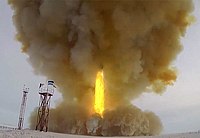UR-100N
| UR-100N | |
|---|---|
| General Information | |
| Type | ICBM |
| Local name | UR-100N, RS-18 |
| NATO designation | SS-19 stiletto |
| Country of origin |
|
| Manufacturer | NPO Maschinostrojenija |
| development | 1970 |
| Commissioning | 1975 |
| Working time | in service |
| Technical specifications | |
| length | 21.10 m |
| diameter | 2500 mm |
| Combat weight | 92,750 kg |
| Drive First stage Second stage |
Liquid rocket engine. Liquid rocket engine |
| Range | 10,000 km |
| Furnishing | |
| steering | Inertial navigation system |
| Warhead | 6 MIRV nuclear warheads with 550 kt each or 1 RV with 2.5-5.0 MT |
| Weapon platforms | Missile silo |
| Lists on the subject | |
The UR-100N , also known as the RS-18 by the Russian armed forces , is a Soviet ICBM from the 1970s. Its NATO code name is SS-19 Stiletto . The Russian strategic missile forces still use missiles of this type.
history
Development began in 1970. The first tests could be carried out just three years later. The first series rockets entered service in 1975. A total of around 360 missiles of this type were stationed in newly built silos. The largest number was placed on the territory of today's Russia (approx. 170), followed by Ukraine as the second most important location. Russia plans to keep some of its UR-100Ns in service until around 2030. For this purpose, 35 never-before-stationed UR-100Ns were used, which Russia bought from Ukraine between 2002 and 2004. The Russian missile forces were able to increase the service time of the UR-100N through regular test starts. However, they may be replaced earlier by the RS-24 . In January 2016, 30 UR-100N were still in service.
Last test flights:
- October 20, 2005
- November 15, 2006
- October 29, 2007
- October 22, 2008
- December 27, 2011
technology
The UR-100N is a further development of the UR-100 . The UR-100N, however, is much larger and more accurate. The length increased to 24 m and the diameter by 25% to 2.5 m. Like the UR-100, the UR-100N uses a two-stage liquid propellant rocket propulsion system that runs on storable liquid propellant (UDMH + NTO). When fueled, the rockets weigh between 103 and 106 tons, depending on the version. The range is around 10,000 km for all versions. A UR-100N can transport a payload of up to 5 t. The 1st version with the GRAU index 15A30 carries 6 re-entry bodies, each containing a nuclear warhead of 550 kt TNT equivalent each. The UR-100N UTTCh (15A35) is a stationed variant with also 6 MIRV per missile. The accuracy has been improved compared to the 15A30, as have the engines, controls and silos. The hit accuracy is between 250 and 920 m, depending on the source and version. According to the START II agreement , all missiles in the US and Russia should only be equipped with one warhead. The treaty did not come into force.
In January 2018, 30 UR-100N UTTCh were stationed in Tatishchevo (together with Topol-M ).
Retired UR-100N UTTCh are partially used as civil launchers ( Rockot and Strela ).
Carrier for hypersonic bodies
According to sources in the Russian Defense Ministry, the UR-100N UTTCh will be used as launch vehicles for the Awangard hypersonic body during a transition period . In 2006 a UR-100N UTTCh with the hypersonic body Awangard was launched from the Jasny Cosmodrome . In March 2018, the commander of Russia's strategic missile forces, Sergei Karakayev, announced that, on the one hand, all tests had been successfully completed and, on the other hand, a contract for the serial production of the Avangard had been concluded. At the end of December 2018, the Russian Defense Ministry again tested the hypersonic glider Awangard from the Jasny cosmodrome, which hit the target on the Kura missile test site .
The launch vehicle for the Awangard hypersonic device is 30 brand-new rockets, which Ukraine handed over to Russia in the 2000s as payment for gas debts. This means that the launch vehicle can operate for over 20 years.
Versions
- 15A30: The original version with 6 warheads of 550 kt each
- 15A35: A slightly improved version of the 15A30
See also
Web links
- Globalsecurity (English)
- Federation of American Scientists (English)
- UR-100N in the Encyclopedia Astronautica (English)
- Russian Strategic Nuclear Forces (English)
- specification
Individual evidence
- ^ Current status - Russian strategic nuclear forces. russianforces.org, January 4, 2020, accessed on January 22, 2020 .
- ↑ The International Institute for Strategic Studies (Ed.): The Military Balance 2018 . 1st edition. Routledge, London 2018, ISBN 978-1-85743-955-7 , pp. 193 (English, January 2018).
- ↑ Источник: первыми носителями гиперзвуковых блоков "Авангард" станут ракеты УР-100Н УТТХ. TASS.ru, March 20, 2018, accessed January 22, 2020 (Russian).
- ↑ Russia tests hypersonic missile: "Avangard" 2019 ready for use. In: Euronews . December 26, 2018, accessed January 22, 2020 .
- ↑ Владимир Тучков: "Авангард": Страшную "ответку" Америке понесет не только МБР "Сармат", но и "Сармат", ".но и" Сармат ",". svpressa.ru, March 22, 2018, accessed January 22, 2020 (Russian).


